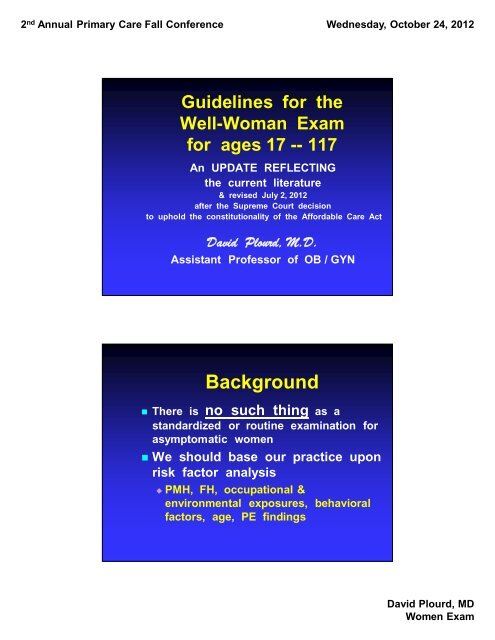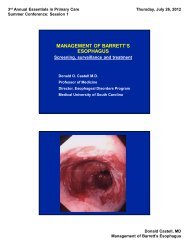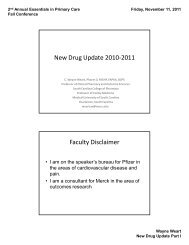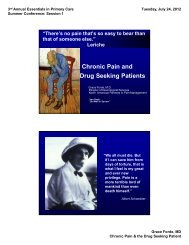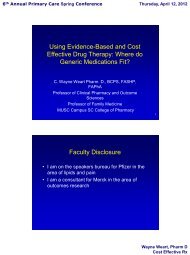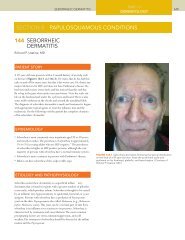Guidelines for the Well-Woman Exam - CME Conferences
Guidelines for the Well-Woman Exam - CME Conferences
Guidelines for the Well-Woman Exam - CME Conferences
You also want an ePaper? Increase the reach of your titles
YUMPU automatically turns print PDFs into web optimized ePapers that Google loves.
2 nd Annual Primary Care Fall Conference Wednesday, October 24, 2012The Landscape ofPeriodic HealthcareScreening is Changing• Recent changes to clinicalrecommendations related to <strong>the</strong>“well-woman visit” Pelvic examination recommendations Cervical cytology recommendations Breast self-exam and mammographyrecommendations• Universal access to healthcarePeriodic AssessmentsAge 17 – 39David Plourd, MDWomen <strong>Exam</strong>
2 nd Annual Primary Care Fall Conference Wednesday, October 24, 2012Sex/Gender Neutral Hx• Marital Status Single Married Domestic-partnered Widowed Divorced Separated O<strong>the</strong>rBasic Components Labs- In Her Teens -- 20’s• Cervical cytology ASCCP 2012 Begin at age 21 IRRESPECTIVE of age of sexualdebut Q 3 yrs -- AGE 21--29 2012 USPSTF, ACS, ASCCP, ASCP,ACOG (Grade A recomm)• Chlamydia screen – if
2 nd Annual Primary Care Fall Conference Wednesday, October 24, 2012A.R.S.: Which of <strong>the</strong> followingis NOT a feature of <strong>the</strong> currentrecommendations <strong>for</strong> cervicalCA screening ? A. Defer initial screen until age 21irrespective of age at onset of sexualactivity B. IF HPV screen is negative in a 25year old, defer next screen <strong>for</strong> 5 years C. Discontinue screening after age 65 ifno CIN 2+ in <strong>the</strong> previous 2 decadesA.R.S: The incidence ofcervical CA among women< 21 years old is A. 1--2 / 10,000 young women B. 1—2 / 100,000 young women C. 1—2 / million young womenDavid Plourd, MDWomen <strong>Exam</strong>
2 nd Annual Primary Care Fall Conference Wednesday, October 24, 2012A.R.S: If an 18 y/o adolescentjust received <strong>the</strong> HPV vaccineseries, how are <strong>the</strong> ASCCP Papsmear screening guidelinesdifferent <strong>for</strong> her, over <strong>the</strong> nextseveral years ? A. Defer her initial Pap until 25 y/o B. After 3 consecutive negative Paps,she may space her screening intervalto q 5 years, having been vaccinated C. No differences in screening2012 ACOG Screening• Begin Paps at age 21 regardlessof age at onset of sexual activityor o<strong>the</strong>r “risk factors” Age 21—29-- Cytology [alone] q 3 yrs Age 30--65 Cytology alone q 3 yrs Preferred: Co-screening [with HPV-HRDNA testing] if neg HPV co-screen,re-screening q 5 years– ACOG Press Release, Mar 14, 2012David Plourd, MDWomen <strong>Exam</strong>
2 nd Annual Primary Care Fall Conference Wednesday, October 24, 20122012 ACOG Screening• Stop screening after total hysterectomy<strong>for</strong> benign conditions with no Hx ofCIN2+ (on pathology or in past 20 yrs)• Evidence of prior negative screening isnot required• Do not screen <strong>for</strong> vaginal CA• Screening should never be resumedeven if a woman reports having a newsexual partner• ACOG Press release. Mar 14, 20122012 ACOG Screening• DC screening after 65 y/o unlessCIN 2+ over <strong>the</strong> previous 2decades NEVER resume screening even if awoman reprots having a new sexualpartner(s) For women with Hx CIN2--3, annualscreening <strong>for</strong> 20 years HPV vaccination does not change<strong>the</strong>se recommendations– ACOG Press Release Mar 14, 2012David Plourd, MDWomen <strong>Exam</strong>
2 nd Annual Primary Care Fall Conference Wednesday, October 24, 20122012 Revised Follow-UpONLY TWO CHANGES• ASC-US / HPV- is managed <strong>the</strong>same as a normal Pap• Normal Pap / HPV+ is evaluated withrepeat co-testing in 12 months, or,if available, immediate HPV 16/18testingAre You ConcernedAbout The NewScreening Intervals ?• The original annual interval wascompletely arbitrary• Papanicolaou and Traut knewnothing of <strong>the</strong> biology / role of HPV• Since 1976, data has shown that q3year screening was as eff’v as q1 yr1018040956David Plourd, MDWomen <strong>Exam</strong>
2 nd Annual Primary Care Fall Conference Wednesday, October 24, 2012Are You ConcernedAbout The NewScreening Intervals ?• ACOG first recommendedleng<strong>the</strong>ning <strong>the</strong> screening intervalin 2003, and again in 2009• The potential harm, in subsequentpregnancies, from over-screening &treating low-grade lesions is real Preventing all CA is unattainable, andundesirableAre You ConcernedAbout The NewScreening Intervals ?• Reproducibility betweenpathologists is modest
2 nd Annual Primary Care Fall Conference Wednesday, October 24, 2012Are You ConcernedAbout The NewScreening Intervals ?• DESPITE <strong>the</strong> <strong>for</strong>egoing, <strong>the</strong> Paphas been largely successfulbecause… Cervical CA has a long latency Of frequent repeating intervals• Paradigm shift: highly reliableHPV-HR-DNA tests now available1018041256Are You ConcernedAbout The NewScreening Intervals ?• HPV/cytologic co-testing is highlysensitive and PV- CIN3+ within 5 years of a neg testis 0.16% Katki H. Lancet Oncol. 2011; 12: 663-72• Potential precancers can beidentified earlierDavid Plourd, MDWomen <strong>Exam</strong>
2 nd Annual Primary Care Fall Conference Wednesday, October 24, 2012Are You ConcernedAbout The NewScreening Intervals ?• A +HR-HPV-DNA test, in <strong>the</strong> presenceof a normal Pap, does NOT warrantimmediate colpo If <strong>the</strong> +HPV persists, or <strong>the</strong> pap turnsabnormal, at 12 mos, THEN colpo ISwarranted Immediate colpo is warranted if +HPV 16 or18 CIN3+ rates approach 10% by 3 yrs–Kjaer S. JNCI. 2010; 102: 1478-88FINALLY THERE’S CONSENSUSCervical CytologicScreening IntervalsOBSOLETE<strong>Guidelines</strong>ACS - 2002Initial Pap 18 y/o or SD SD+3 or21yoUSPSTF-2003SD+3 or21yoACOG / ACS /ASCCP /ASCPUSPSTF 201221yo (irrespof SD)s/p HystB9 dz)Upper agelimitPap interval 30 y/o(<strong>for</strong>Q 3-5 yrs Never again Never again Never againnoneannual70 ( 3 nl’s; noabnl x 10 yrs)q1yr (conv’l);q2yr (LBC)65 (if previouslynl)At leastq3 yrsannual q 2-3 yrs At leastq3 yrs65 (if previouslynl)q 3 yrsq 3/5 yrsDavid Plourd, MDWomen <strong>Exam</strong>
2 nd Annual Primary Care Fall Conference Wednesday, October 24, 2012Each of <strong>the</strong> following is acorrect indication <strong>for</strong> HPV –DNA virotyping EXCEPT• A. Primary “co-screening” alongwith cytology ( Pap smear ) afterage 30• B. To triage an ASCUS Pap smearresult• C. To diagnose genital wartsA.R.S. AnswerEach of <strong>the</strong> following iscorrect EXCEPT• A. Primary “co-screening” alongwith cytology ( Pap smear ) afterage 30• B. To triage an ASCUS Pap smearresult• C. To diagnose genital wartsDavid Plourd, MDWomen <strong>Exam</strong>
2 nd Annual Primary Care Fall Conference Wednesday, October 24, 2012When To Do HR – HPVTesting• 1. NEVER be<strong>for</strong>e age 21• 2. To triage an ASCUS Pap smearresult (> age 21)• 3. As primary “co-screening”(> age 30)• NEVER do LR-HPV (Low-risk)virotyping1018040856HPV-DNA TestingNOT Indications• Co-screening at
2 nd Annual Primary Care Fall Conference Wednesday, October 24, 2012HPV-DNA TestingNOT Indications• For any adolescent ( 30 y/o• Specificity improves as prevalencedecreases Prevalence of HPV+ is >70% @ 18-22 y/o Prevalence of HPV+ is 30• Kulasingami. JAMA. 2002; 288: 1749• Eltown I. Cancer. 2005; 105: 194-8 (Level II-3)David Plourd, MDWomen <strong>Exam</strong>
2 nd Annual Primary Care Fall Conference Wednesday, October 24, 2012Theoretic Reduction ofRisk of False-negs byShorter SamplingInterval• 1 smear ……………………………..20%• 2 smears 20% of 20%………………4%• 3 smears 20% 3 ………………………0.8%Why Does <strong>the</strong> EvidenceNot Support ThisReduction ??• False negatives are not a randomchance event• Some lesions grow more rapidly• Some lesions exfoliate lessDavid Plourd, MDWomen <strong>Exam</strong>
2 nd Annual Primary Care Fall Conference Wednesday, October 24, 2012Risk Factor Stratification<strong>for</strong> Screening• Risk factors should not dictate <strong>the</strong>interval of screeningRisk factors can only indicate who ismost likely to benefit from screening• Testing interval should be dictated by• 1) rate of progression• 2) FNR of <strong>the</strong> test Frame,J. J Am Board Fam Prac 1998; 11: 87--90Why Wait Until 21 y/oin Adolescents ?• HSIL’s are rare in adolescents CIN3 in 15-19 y/o’s: 3/10K/year 4 years w/ persistent HPV infection,CIN2/3 rate is
2 nd Annual Primary Care Fall Conference Wednesday, October 24, 2012Cervical CytologicScreening - In Her 20’s• Cervical cancer screening should begin atage 21 regardless of age at onset ofsexual activity.• Cervical cytology screening from age 21 to29 is recommended every 3 years butshould be more frequent in women who areHIV-positive, are immunosuppressed, wereexposed in utero to diethylstilbestrol, or havebeen treated <strong>for</strong> cervical intraepi<strong>the</strong>lialneoplasia (CIN) 2, 3 or cervical cancer. ACOG Practice Bull. #431, 2009Cervical CytologicScreening• Women with histories of CIN 2+ shouldundergo annual screening <strong>for</strong> 20 yearsafter treatment.•• HPV vaccination does not changeany of <strong>the</strong> <strong>for</strong>egoing recommendations.David Plourd, MDWomen <strong>Exam</strong>
2 nd Annual Primary Care Fall Conference Wednesday, October 24, 2012Don’t Get Caught Up…Don’t Lose Perspective• The central purpose in screening isto detect HIGH GRADE LESIONS• CIN 2,3, CIS, CxCA Most LSIL, esp in young women,represents ACUTE HPV infection80% resolve by 1 year (91% by 3years) without intervention Evaluate ASC / LSIL to eval <strong>for</strong> HSIL Preventing all cervical CA’s isunattainable / undesirable2012 RevisedScreening <strong>Guidelines</strong>• GOOD news <strong>for</strong> women andproviders Simpler less frequent screening withbetter outcomes than with priorscreening techniques Allows more time <strong>for</strong> o<strong>the</strong>r prioritiesat <strong>the</strong> “annual visit” Less CA’s; avoiding harm• http://CAonline.AmCancerSoc.orgDavid Plourd, MDWomen <strong>Exam</strong>
2 nd Annual Primary Care Fall Conference Wednesday, October 24, 20122012 Revised ScreeningSUMMARY STATEMENTS• No screen is perfect• The ideal balance between benefitand harm should be chosen (costwas NOT considered in <strong>the</strong>seguidelines)• The guidelines, stratified only <strong>for</strong>age, assume a healthy population Do not misapply to women withrecent CINSo Now What Happensto <strong>the</strong> “Annual <strong>Exam</strong>”?• Previously <strong>the</strong> annual Pap waslinked to <strong>the</strong> annual exam• Now, we can spend that time on Heart disease - causes more deathsthan all female CA’s combined Weight loss, tobacco cessation Screen <strong>for</strong> HTN STI screeningDavid Plourd, MDWomen <strong>Exam</strong>
2 nd Annual Primary Care Fall Conference Wednesday, October 24, 2012So Now What Happensto <strong>the</strong> “Annual <strong>Exam</strong>”?• Contraceptive choices• Address sexuality issues• Menopausal health• Osteoporosis – fall prevention• Breast cancer screening• Domestic violence• Depression screeningAnnual <strong>Well</strong>-<strong>Woman</strong> <strong>Exam</strong>• To detect & treat any new orongoing health problems• To help prevent future ones Health status Nutrition Physical activity Sexual practices Tobacco/alcohol/drug use Height, weight, BMI ACOG Comm. Opinion #483 April, 2011David Plourd, MDWomen <strong>Exam</strong>
2 nd Annual Primary Care Fall Conference Wednesday, October 24, 2012So Now What Happensto <strong>the</strong> “Annual <strong>Exam</strong>”?• SUMMARY• These new guidelines will permitus to provide expert care inwomen’s health to our patientswho seek our guidance on suchdiverse matters.Preventive Services <strong>for</strong> WomenUnder <strong>the</strong> Af<strong>for</strong>dable Care Act• Multiple services must be providedWITHOUT cost-sharing (deductible,co-insurance, or co-pay) :• DHHS-HRSA, April 30, 2012• IOM. Wash D.C. Nat’l Acad Press. 2011• DHHS Sec’y Kathleen Sebelius adopted <strong>the</strong>se IOMrec’s in full effective Aug 1, 2012 Included in <strong>the</strong> Af<strong>for</strong>dable Care ActDavid Plourd, MDWomen <strong>Exam</strong>
2 nd Annual Primary Care Fall Conference Wednesday, October 24, 20128 Recommendations <strong>for</strong>Girls/Women 10—65 y/o• 1. GDM screening between 24-28wks (or at 1 st PNC if hi-risk)• 2. Co-testing <strong>for</strong> HPV at age >30• 3. Annual STI counseling <strong>for</strong>sexually active women/girls• 4. Annual HIV counseling andscreening <strong>for</strong> sexually active …8 Recommendations <strong>for</strong>Girls/Women 10—65 y/o• 5.* Coverage <strong>for</strong> FDA-approvedcontraceptive methods, sterilization, andcounseling (*strongest evidence of benefits)• 6. Comprehensive lactation support,counseling, and rental equipment• 7. D.v. Counsleing & screening• 8. At least one annual well-womanscreening, incl. preconception counseling,and <strong>the</strong>n prenatal care (can see both fammed, OB/GYN, <strong>for</strong> her annual screens)David Plourd, MDWomen <strong>Exam</strong>
2 nd Annual Primary Care Fall Conference Wednesday, October 24, 2012The Next SeveralClinical Dilemmas When is a pelvic exam appropriate Speculum Bimanual When is a rectal exam appropriate When is a Pap smear indicatedWhat about <strong>the</strong> annualexam ??• The liberalized cervical cytologicscreening intervals does NOTtranslate to less frequent femalehealthcare screening e.g. annual chlamydia testing @ age < 25if sexually activeDavid Plourd, MDWomen <strong>Exam</strong>
2 nd Annual Primary Care Fall Conference Wednesday, October 24, 2012ACOG 2012 on“Annual <strong>Exam</strong>s”• Age 19 - begin annual abdominaland breast exams• Age 21 - begin cervical cytologicscreening• There’s more to women’s healththan a Pap test; comprehensiveannual well-woman exam Dr. Gerald Joseph, ACOG VP of Practice ActivitiesWhat about <strong>the</strong>“Routine” Pelvic <strong>Exam</strong> ???? Does STI screening / testing require apelvic exam ?? ?? Does her request <strong>for</strong> contraceptionrequire a pelvic exam ?? ?? Should it be a part of <strong>the</strong> primarycare “well-woman exam” ?David Plourd, MDWomen <strong>Exam</strong>
2 nd Annual Primary Care Fall Conference Wednesday, October 24, 2012For STI Screening• Amplified DNA technology permitstesting on a urine or vaginal swabspecimen NO pelvic / cervical exam required(except to evaluate <strong>for</strong> “PID” )For PrescribingContraceptionACOG Recommendations• “A pelvic examination is notrequired in order to prescribehormonal contraception”• Felicia Stewart Clinical Breast and Pelvic<strong>Exam</strong>ination Requirements: Current Practice vs.Evidence JAMA 2001; 285: 2232-9David Plourd, MDWomen <strong>Exam</strong>
2 nd Annual Primary Care Fall Conference Wednesday, October 24, 2012Pelvic <strong>Exam</strong>ination• Vaginal Speculum Not evidence based Not required after Hyst & BSO <strong>for</strong> B9dzz (still examine external genitalia);nor is bimanual required in thissettingPelvic <strong>Exam</strong>ination• Bimanual ACOG recomm: @13-20 y/o -ONLY do it as indicated (e.g.AUB, amenorrhea, STD, mass, discharge);becomes routine Annually as of age 21 (no evidence tosupport or refute benefits – <strong>for</strong> low-risk pt.) After Hyst & BSO <strong>for</strong> B9 dzz (still examineexternal genitalia) – no longer required ref: ACOG Comm. Opinion #534, Aug, 2012) USPSTF states that <strong>the</strong>re is insufficientevidence to argue <strong>for</strong> or against bimanualexam in a’sx’tic women at increased risk<strong>for</strong> ovarian cancerDavid Plourd, MDWomen <strong>Exam</strong>
2 nd Annual Primary Care Fall Conference Wednesday, October 24, 2012Bimanual <strong>Exam</strong>ination• Screening women at average risk<strong>for</strong> ovarian CA Pelvic exam findings can lead toanxiety and unnecessary testing Unjustified given <strong>the</strong>• Low prevalence of disease• Low sens/spec of <strong>the</strong> exam• 98% of positive findings are false+– Stormo A. 2011; 171(22): 2053-4General <strong>Exam</strong> Screening
2 nd Annual Primary Care Fall Conference Wednesday, October 24, 2012General <strong>Exam</strong> Screening21 – 29 y/o• Annual pelvic exam w/ Pap q 3 yrs•
2 nd Annual Primary Care Fall Conference Wednesday, October 24, 2012HIV Screening at Home• June, 2012 – FDA approved <strong>the</strong> firsthome kit <strong>for</strong> self testing usingbuccal saliva / smear.
2 nd Annual Primary Care Fall Conference Wednesday, October 24, 2012Screening <strong>for</strong> Breast CAAge 19--39If a first-degree family memberwas diagnosed with breast CAbegin screening at 10 yearsyounger than <strong>the</strong> age ofdiagnosis in her familymemberLabs <strong>for</strong>High-risk Patients• TSH – FH thyroid dzz, autoimmune dzz• Hepatitis C virus testing Hx IV drugs, clotting factors (
2 nd Annual Primary Care Fall Conference Wednesday, October 24, 2012When to Consider BMDMeasurement in Young WomenEvidence Based Points – Use Z -score• The indications <strong>for</strong> measuring premenopausalBMD are: Malabsorption syndromes (level III) O.I. or o<strong>the</strong>r heritable bone disorders (III) >3 mos chronic steroids >2.5 mg/d pred (II-2) > 10 years chronic hypoestrogenism (II-2) Hx vertebral compression fracture Thalassemia major Chronic immobilization (e.g. Cerebral palsy)• Rubin L. JBMR. 1999; 14: 633-43BMD in Adolescents• Stress fractures in adolescents ormarathoners are NOT fragility fractures DXA is not indicated Consider anorexia / eating disorders• When DXA is indicated in anadolescent T-scores are inappropriate andmeaningless Z-score < -2.0 = “Low BMD <strong>for</strong>chronological age”David Plourd, MDWomen <strong>Exam</strong>
2 nd Annual Primary Care Fall Conference Wednesday, October 24, 2012Ages 17—39 continued• Immunizations HPV vaccine (40David Plourd, MDWomen <strong>Exam</strong>
2 nd Annual Primary Care Fall Conference Wednesday, October 24, 2012Basic Components Labs• FBS – q 3 yr @ 45 y/o• TSH – q 5 yr @ 50 y/oBasic Components Labs• Colorectal CA screening - @ 50 y/o ACG – recomm African-Amer’s begin @ 45 Annual pt-collected fecal occult blood Or fecal immunochemical test (F.I.T.),or stool DNA test Q 5 yr flex sig Both of above Q 5 yr double-contrast BE Q 10 yr colonoscopyDavid Plourd, MDWomen <strong>Exam</strong>
2 nd Annual Primary Care Fall Conference Wednesday, October 24, 2012Whose <strong>Guidelines</strong> ?• USPSTF – United States PreventiveServices Task Force• ACOG - Amer College of OB/GYN• ACS – American Cancer Society• NCCN – National ComprehensiveCancer NetworkMammographyScreening <strong>Guidelines</strong>• USPSTF (2009)USPSTF’sreason based on old data 1986-2006 Q 2 years <strong>for</strong> women ages 50--74 (<strong>for</strong>women at average risk) – Level B Screening be<strong>for</strong>e age 50 should NOTbe done routinely Base upon woman’s individual valuesregarding risks and benefits – Level C• 15% reduction in mortality rate at ages 39—49• 1,904 women screened x 10 yrs to prevent 1breast CA mortality (vs 1,339 <strong>for</strong> 50—74 y/o)Do not teach SBE – Level DDavid Plourd, MDWomen <strong>Exam</strong>
2 nd Annual Primary Care Fall Conference Wednesday, October 24, 2012MammographyScreening <strong>Guidelines</strong>• ACOG, ACS, NCCN all concur Yearly beginning at age 40 vs. USPSTF points out• 1. Risks (e.g. false +’s leading toneedless biopsies and worry)• 2. lower prevalence – so lower PV+and greater NNS to prevent 1 death SBE is optional“I’m Worth It”41 y/o whose OB/GYNordered an initialmammogram at age 40A tiny lesion was seen.Needle-directed biopsy wasdone. Tumor Board metand recommended localexcision and radiation.David Plourd, MDWomen <strong>Exam</strong>
2 nd Annual Primary Care Fall Conference Wednesday, October 24, 2012MammographyScreening <strong>Guidelines</strong>Insufficient Evidence• USPSTF (2009) [but based on old data1986-2006 ] INSUFFICIENT EVIDENCE FOR … After 75 y/o ( no mortality reduction ) Whe<strong>the</strong>r CBE adds value toscreening mammography The benefits / harms of digitalmammography or MRI instead ofconventional film mammographyUp to Date – Sep 2010• Strong evid <strong>for</strong> mammo 50—69 -stronger evid than <strong>for</strong> any o<strong>the</strong>rCA (mammo’s at 40-50 definitely decreases Br CA mort –but is a rare condition – found at high cost)• Film (vs digital mammo) – optimal<strong>for</strong> > 50 y/o Digital may offer advantage inyounger women with dense breasts Pisano 2005; Skaane 2007; Vinnicombe 2009• Q 2 yrs screening is 81% as goodas annual mammo. (Mandelblatt – 2003)David Plourd, MDWomen <strong>Exam</strong>
2 nd Annual Primary Care Fall Conference Wednesday, October 24, 2012Up to Date --2010• For >50 y/o q 2 yrs is fine sincetumors are slower growing• 2007 ACS strictly recomm AGAINSTMRI in low (
2 nd Annual Primary Care Fall Conference Wednesday, October 24, 2012BSE - Cochrane DatabaseReview and Meta-analysis• 2 large population studies• Nearly 400,000 women• BSE vs not : no statistically significantdifferences in breast CA mortality Kosters. The Cochrane Library. Issue 4; 2003• Almost twice as many biopsies withbenign results were per<strong>for</strong>med in <strong>the</strong>BSE group vs <strong>the</strong> no-BSE group Hackshaw. Br J Cancer. 2003; 88: 1047-53Cochrane DatabaseConclusions -- SBE• “The data do not suggest abeneficial effect of screening byBSE whereas <strong>the</strong>re is evidence <strong>for</strong>harm. At present BSE cannot berecommended.”• “It is no longer recommended toteach BSE during <strong>the</strong> periodicwell-woman visit”David Plourd, MDWomen <strong>Exam</strong>
2 nd Annual Primary Care Fall Conference Wednesday, October 24, 2012CBE Data• Sensitivity - 58.8%; specificity - 93.4%• 1000 CBE’s to detect 5 CA’sOnly modestly improvesupon mammography alone• Bobo J. JNCI. 2000; 92: 971-6 (level II-3)• Not well taught or standardized Recomm 3 min per breast, plus axillae,SC nodes, etcCBE RecommendationsACOG & ACS & NCCN• ACOG - Amer College of OB/GYN• ACS – American Cancer Society• NCCN – National ComprehensiveCancer Network• Q 1—3 yrs ages 20—39*• Annually after 40 y/o* * no evidence to support guidelinesDavid Plourd, MDWomen <strong>Exam</strong>
2 nd Annual Primary Care Fall Conference Wednesday, October 24, 2012Ages >40 continued• Hearing testing• Glaucoma test q yr @ 60 y/o• SBE (despite a lack of convincing data <strong>for</strong>or against)• Suicide: depression screen• Tobacco, ETOH, drug abuse• Chemoprophylaxis (SERM) <strong>for</strong> Br CA For high-risk women ACOG Tech. Bull. #39. 2002; 100: 835-43• Sun exposureAges >40 continued• Immunizations Influenza q yr @ 50 y/o Tdap x 1; Td q 10 yrs No upper age limit to Tdap• ACIP Oct 28, 2010• FDA July 8, 2011• High-risk MMR, Hep A, Hep B, influenza, MCV4,pneumococcal, varicellaDavid Plourd, MDWomen <strong>Exam</strong>


